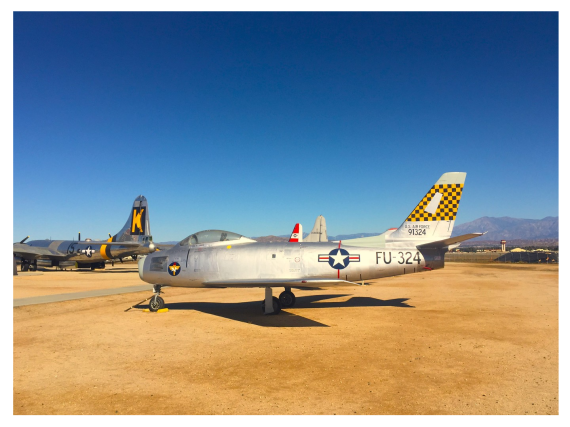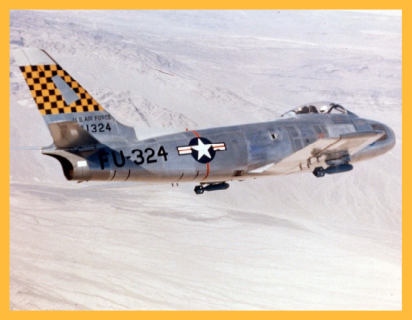F-86 A North American
| Manufacturer: | North American | ||
| Designation: | F-86 | ||
| Version: | A | ||
| Nickname: | Sabre | ||
| Type: | Fighter | ||
| Crew: | Pilot | ||
| Specifications | |||
|---|---|---|---|
| Length: | 37' 6" | ||
| Height: | 14' 8" | ||
| Wingspan: | 37' 1" | ||
| Armament: | 6 .50 caliber M3 machine guns | ||
| Propulsion | |||
| No. of Engines: | 1 | ||
| Powerplant: | General Electric J47 | ||
| Thrust: | 5,200 lbs | ||
| Performance | |||
| Max Speed: | 685 Mph | ||
| Ceiling: | 49,000 | ||
| Range: | 1200 miles | ||
The United States Air Force’s first swept wing fighter the North American F-86 Sabre became an aviation legend in the hands of skilled US pilots in the hotly contested skies of “MiG Alley” during the Korean War.
Designed late in the World War 2 the first prototype F-86s did not fly until 1947 allowing the US design team to take advantage of captured German technical data relating to the advantages of swept wing designs in high-speed jet fighters. Powered by a General Electric J47 turbojet and armed with six .50 caliber machine guns the F-86 Sabre entered USAF service in 1949.
When war broke out on the Korean peninsula, F-86 Sabres were rushed to the Far East after older-model US fighters proved no match for the nimble MiG-15s of the communist forces. By the end of the conflict, USAF Sabres were credited with the destruction of 792 MiG-15s for the loss of 78 F-86s, an astonishing ten to one success rate. Later, after the fall of the Soviet Union when records became available, the rate was revised to a still respectable 1.8 to 1 by the 2008 Rand Corporation study "Air Combat Past, Present and Future."
With 7,800 F-86 aircraft manufactured between 1949 and 1956, and an additional 1,815 built in Canada and Australia for a total of 9,615 the F-86 was by far the most produced western block fighter of all time.
The museum’s F-86A serial number 49-1324 (on loan from the USAF) was manufactured by North American Aviation, Inglewood CA and delivered to the Air Force on October 23, 1950, where it was assigned to the 3595th PTW Nellis. 49-1324 represents a milestone in Fighter Combat Training as the 3595th PTW specialized in preparing USAF pilots for combat against the latest Soviet MiG-15 fighters in use in Korea. Drawing pilots experienced in aerial combat against MiGs (including Col George Jones, 6 MiG kills in Korea and the commander of the 3595th) the squadron was the forerunner of the Air Force’s Red Flag and the Navy’s Top Gun schools.
After its active-duty service 49-1324 continued with the Air National Guard in Wisconsin, California, and Nevada before beginning placed on static display in various locations ending in Salt Lake City, Utah in the 1980’s Scheduled for scrapping, March Field Air Museum recovered 49-1324 from Salt Lake City in 2022and restored her to its current display condition.
Curiously, during the initial phase of restoration Alex LaBonte, Restoration Manager MFAM discovered three heavily corroded, linked 7.62 shell casings in the left side of the nose gear compartment tucked behind a subframe. Examining the casings, he discovered and removed a tightly rolled note (see photo).
The location and content of the note raises the interesting prospect of the aircraft static display having been used as a “Dead Drop.” A dead drop is a method of covert information transmission often used by Intelligence services and criminal organizations. Public locations are used to permit the passing of written communication without face-to-face contact, or the risk of detection through conducting suspicious activity at isolated locations.
The location of the shell casings would have been accessible only when the aircraft nose gear was down, and the gear doors open. Displayed on the ground, with its landing gear extended, the casings would be easily retrievable by someone who knew it was there, but completely concealed from the casual observer.
The 1974 Lake City Arsenal dates on the 7.62 casings indicate the note could only have been placed after 1974, current information creates the strong possibility the casings were placed in the aircraft during its ground display period at Roland Wright ANG from 1981 to 1986.
A period photograph of F-86A 49-1324 during its time with the 3595th at Nellis, AFB in the early 1950s.





